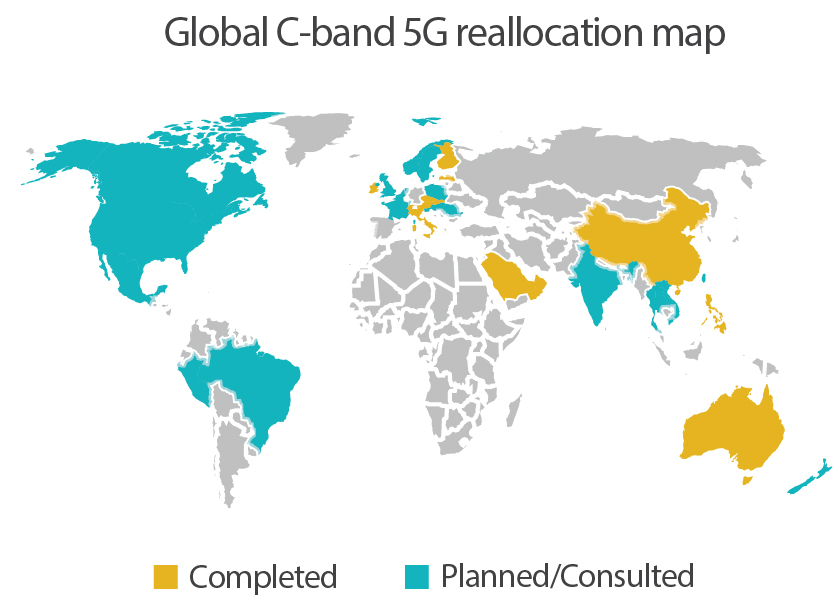Daily News
The migration from terrestrial to satellite-based video distribution

On November 19, 2019, Ajit Pai, chairman of the United States Federal Communications Commission (FCC), announced a public auction of the C-band spectrum 1 (about 500 MHz of bandwidth between 3.7 to 4.2 GHz) to facilitate the development of 5G. The C-band, a swathe of satellite spectrum that has been historically used for fixed wireless services, plays a crucial role in broadcasting and live production of content like news reporting and sports feeds.
Enabling 5G adoption
According to the directive, the FCC has earmarked 280 MHz of bandwidth, instead of the originally expected 180 MHz, to be auctioned for mobile network operators. This leaves less than half of the spectrum, about 200 MHz, to be preserved for TV programming. Moreover, the FCC’s announcement of a USD 9.7 billion payout to satellite companies ahead of the 5G auction has introduced further confusion to an already uncertain landscape.
These developments could give rise to potential challenges for broadcasters such as operational risks with interference at the downlinks and decreased spectrum supply may lead to increase in costs.
The US is not the only country to announce the release of the C-band spectrum for 5G development. While regions like China and South Korea have been closely following the FCC’s actions with intentions to follow suit, various regions in Europe and Asia have, since 2015, auctioned or allocated the C-band spectrum for mobile broadband. For instance, France has approved the allocation of C-band licenses through four 50 MHz blocks. In the UK, Ofcom declared the C-band spectrum will be central to the rollout of 5G networks. And in 2018 it concluded the first auction of the spectrum by selling 150 MHz of the C-band spectrum.
The proposed US solution requires interference protection for existing C-band Earth stations, based on their specific locations and characteristics. C-band satellite is the primary content distribution link to millions of US viewers, received by thousands of C-band stations feeding cable and other distribution networks. C-band receive-only stations are being identified and registered, to ensure their protection by geographical separation from base stations and other technical measures.
However, the US solution may not work in the Indian and some parts of the Asia Pacific region. Reasons include the large numbers of administrations and satellite operators, greater service diversity, orders of magnitude more C-band earth stations, including many under blanket licenses lacking location details, with more even urban/rural distribution, and of smaller diameter (thus susceptible to interference from wider cones), greater cost sensitivity, and lack of compensation for spectrum loss and/or necessary technical protection measures.
Thankfully, there are other viable 5G spectrum options in the Asia-Pacific region, according to AVIA. Allocating and filling feasible free frequencies first from the lowest upward enhances efficiency. Many countries have yet to license mid-band 2.3 and 2.6 GHz bands. With global allocations for IMT services, and 5G trials and tests already under way in the 2.6 GHz band, these bands will undoubtedly become future terrestrial 5G bands and could afford much better solutions in the Asia-Pacific region than C-band.
Proven spectrum currently used by 2G, 3G, and 4G services should also progressively be reallocated for 5G services. Millimeter-wave bands with over 33 GHz new spectrum over 41 times the 800 MHz 3.4 to 4.2 GHz C-band are also being examined for possible identification for IMT services, following ITU Resolution 238 at WRC-15. Opening 10 GHz of spectrum from 66-76 GHz using existing co-primary mobile allocations would, for example, triple the available spectrum for IMT, affording significant future-proofing for 5G IMT-2020.
Operational challenges
In 2016, the global value of subscriptions and pay-per-view television hit a peak point of USD 205 billion. By 2024, it is expected to drop 17 percent to USD 171 billion. And according to PwC’s Global Entertainment and Media Outlook, the global spending on traditional television and home video is on a steady decline; estimated to fall to USD 244 billion by 2023. In 2016, this number stood at USD 258 billion.
The drop in revenues and consumer spending is indicative of the challenges that broadcasters face today. Chief among them has been the rise of alternative media channels, such as OTT streaming media services like Netflix and Amazon. A report by MarketsandMarkets estimated the global OTT market to grow at a CAGR of 14 percent, reaching a value of USD 156.9 billion by 2024. The rapid growth of OTT streaming media and subscription-based video-on-demand (SVoD) viewership, particularly, has had a significant impact on the way content is prepared and delivered. The major cause of this is a shift in media consumerism.
This growth of mobile and streaming services combined with the demand for ultra-HD content is compelling broadcasters to explore efficient ways to manage and deliver content.

One outcome of this shift has been the emergence of TV everywhere. By operating on a model similar to VoD, TV everywhere allows pay-TV operators to provide a multi-device on-demand viewing experience as a value-add to retain viewership. But the risks involved have kept many broadcasters from adopting this model. Adopting new media platforms to reach out to the cord-cutting consumer can leave broadcasters potentially vulnerable to security and piracy threats. Research reveals that the benefits promised by streaming media has been largely capped by digital piracy issues. In fact, digital piracy cost, just the US economy, almost USD 29.2 billion every year.
Moreover, with cutbacks on the availability of the C-band spectrum, wireless mesh networks that use multi-hop, uplink-downlink provide broadcasters with an alternate opportunity for international distribution. However, the introduction of intermediary nodes in a multi-hop network could lead to increased latency and risks of leaked or faded information.
Fiber-based distribution, an alternative to satellite-based distribution
The 1980 Winter Olympics held in Lake Placid, New York was the first instance of broadcasters using fiber-optic cable for the transport of broadcast television signal. It was used for a video transmission system for backup video feeds. The 40-year long history of fiber as a medium of transporting video signals is proof that fiber-based broadcasting is an indispensable part of the broadcasting ecosystem.
When compared with satellite-based broadcasting at a service level, fiber-based distribution has a clear advantage in ensuring an uninterrupted high-quality feed. Their capacity to transmit high-resolution signals across long distances and at fast speeds, without the risk of degradation makes them a superior mode of video distribution.
The obvious advantage of fiber-based distribution has encouraged numerous broadcasters to test its waters in preparation to move away from satellite-based distribution. For instance, cable giant Charter Communications has expressed plans to shift a vast majority of satellite-based C-band television broadcasts over to fiber.
The use of fiber-based video transmission systems in sports and live content broadcasting has come a long way as well. During the 2019 Players Championship in Ponte Vedra Beach, Florida, PGA TOUR deployed a fiber video distribution rack. This allowed them to bypass excessive cable runs and, in the process, make the production more efficient.
Just a yard short: The limitations of fiber-based distribution
The advantages of fiber-based distribution are numerous. However, there are some inherent limitations that continue to restrict broadcasters from adopting a fiber-based distribution model. One such impediment is the limited number of physical endpoints. This issue is most prominent in developing economies, such as India and South Africa, where access to fiber is limited and expensive.
Internet-based distribution: The next frontier of broadcasting
The growth of OTT streaming media services and broadcasters exploring ways of non-linear media distribution implies one undeniable fact: the internet is going to be the mainstream medium of distribution in the future.
The most obvious benefit of using the internet as a carrier (IP-based distribution) is that the audience is already on the internet. This ensures a larger audience and greater reach as compared to cable or terrestrial distribution channels. The widespread, bidirectional nature of an IP-based distribution model could also pave the way for broadcasters to address the audience fragmentation concern. Instead of focusing on a given broadcast coverage area, broadcasters could leverage an internet-based distribution strategy to diversify content and cater to the needs of individual markets. This, in turn, would ensure long-term audience retention for them.
Another factor that works in favor of IP-based distribution is the cost advantage. A 53.6 percent global online access rate means a majority of the world’s population already has access to the internet. This saves broadcasters the added burden of developing and managing a dedicated delivery infrastructure.
The setbacks of internet-based distribution. Internet-based distribution over an open network, however, comes with its own set of challenges. One of these is the lack of guaranteed quality of service (QoS).
Adapting to strategize: An all-inclusive hybrid distribution model

Solving the QoS issue of internet-based distribution
With the rise of IP-based broadcasting, there is a severe need for managed services in order to provide viewers with a low-latency feed. The concept of IPTV brings together the reliability of satellite-based distribution as well as the operational and cost advantages of internet-based distribution.
A hybrid IP-based distribution model delivers broadcast content from satellites while leveraging a managed content delivery network (CDN) to deliver higher QoS. This allows it to retain the non-linear, bidirectional video distribution of an IP-based distribution model while eliminating the latency issues of an IP-based distribution model.
A video connect edge solution helps broadcasters achieve this through its end-to-end managed service layers. Moreover, the solution consists of a majority of the network core bandwidth. By leveraging a global private network followed by public internet for first- and last-mile connectivity allows broadcasters to provide a high degree of reliability through the hybrid network. The platform allows for feeds at an ultra-low latency in sync with satellite distribution.
The fully managed service offered by the video connect edge solution allows broadcasters to operate on their preferred IP-based delivery architecture. Additionally, a strong network presence in the region enables a hybrid satellite alternative for a large segment of potential consumers.
Looking to the future
The broadcasting sector is not new to disruptions. The industry has successfully navigated technological and cultural waves in the past. And there is no reason to believe that this wave of disruption will be any different. In order to do so, broadcasters need to undertake the strategic imperative of catering to the dynamic consumer behavior. For an industry like broadcasting, that is largely dependent on a linear business model, this may be the most difficult hurdle yet. But by choosing the right technologies and platforms, broadcasters have the opportunity to reinvent themselves in this new world of possibilities.
Based on The Great Broadcasters’ Migration: A Terrestrial Alternative to Satellite-based Video Distribution, a report by Tata Communications.





You must be logged in to post a comment Login